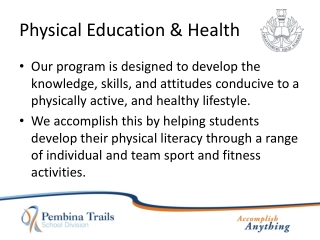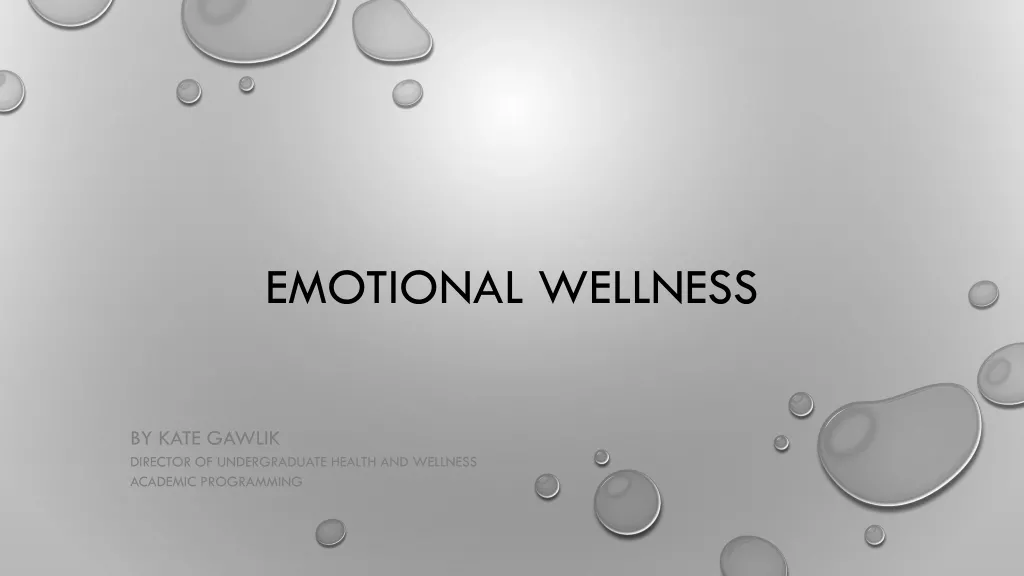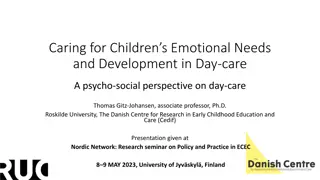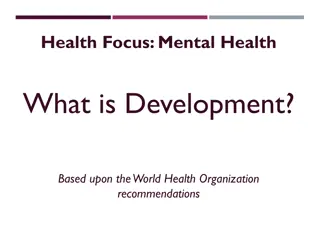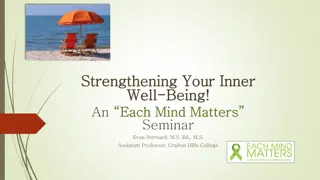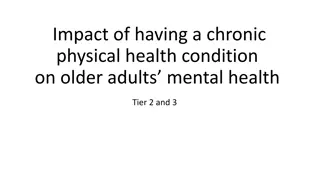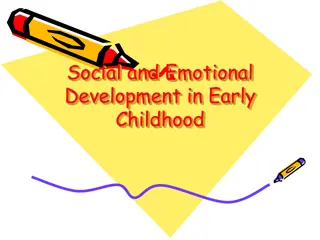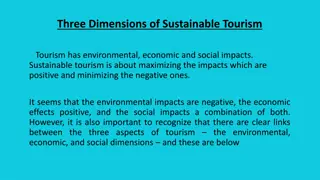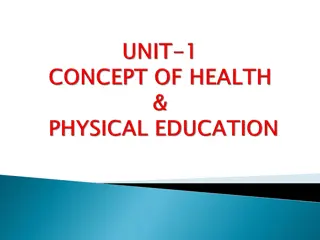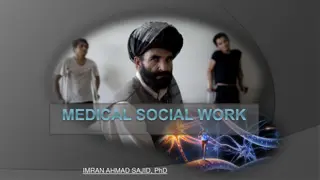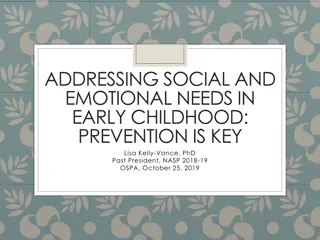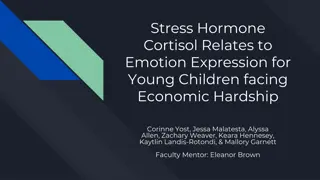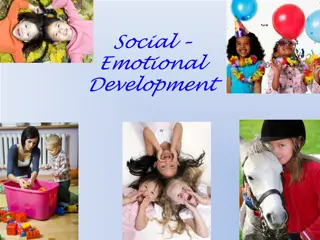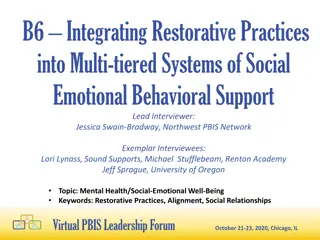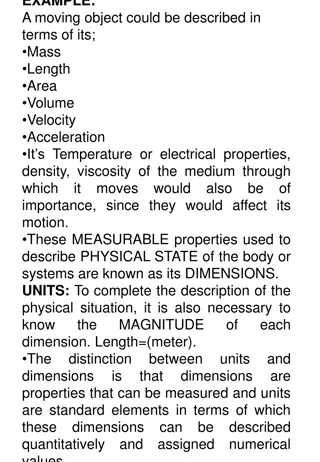Understanding the Three Dimensions of Health: Physical, Emotional, and Social
Explore the different facets of health through the Health Triangle model, which includes physical, emotional, and social well-being. Learn how each aspect contributes to overall wellness and discover elements of physical and mental/emotional health that are essential for a balanced lifestyle.
Download Presentation

Please find below an Image/Link to download the presentation.
The content on the website is provided AS IS for your information and personal use only. It may not be sold, licensed, or shared on other websites without obtaining consent from the author. Download presentation by click this link. If you encounter any issues during the download, it is possible that the publisher has removed the file from their server.
E N D
Presentation Transcript
Wellness Wellness Unit Unit
How do you know if someone is healthy? *Most people think that they are healthy if .. *Most people think that they are healthy if .. 1. They are not sick 1. They are not sick 2. If they are not overweight 2. If they are not overweight 3. They do not drink alcohol or smoke cigarettes. 3. They do not drink alcohol or smoke cigarettes. There are three parts to your health: There are three parts to your health: Physical Physical Social Social Mental/Emotional Mental/Emotional
Health Triangle Physical Side Physical Side Social Side Social Side Social Side Social Side Mental/Emotional Side Mental/Emotional Side
Health Triangle Health Triangle: : Physical Side Physical Side: the condition of your body : the condition of your body Mental/ Emotional Side Mental/ Emotional Side: your thoughts, feelings : your thoughts, feelings and emotions and emotions Social Side Social Side: the way you relate to others : the way you relate to others Health Health: is the : is the combination emotional emotional and social well being and social well being. . combination of physical, of physical, mental mental/ /
Which side of health ????? Physical, Emotional or Social Walking a dog Shoveling snow Eating a banana Talking to a counselor Playing on a sports team Writing in a journal Attending a school dance Taking deep breaths Working on a group project with classmates Studying for a test
Elements of Physical Health Elements of Physical Health A.Keep fit and A.Keep fit and exercise exercise B. Eat a B. Eat a balanced balanced diet diet C. Maintain ideal C. Maintain ideal weight weight D. Good D. Good grooming grooming E. Avoid E. Avoid drugs drugs F. Get F. Get rest rest/ 8 / 8- -9 hours of sleep a night 9 hours of sleep a night
Elements of Mental/Emotional Elements of Mental/Emotional Health Health A. A. Accept Accept yourself for who you are yourself for who you are B. Express your B. Express your feelings feelings C. Develop decision C. Develop decision- -making making skills skills D. Learn to deal with D. Learn to deal with problems problems E. Learn to handle E. Learn to handle stress stress
Depression Depression Depression: feeling sad, unhappy, discouraged : feeling sad, unhappy, discouraged Causes: Causes: 1. Death 1. Death 2. Divorce 2. Divorce 3. Moving 3. Moving Signs Signs: : 1. Affects school performance 1. Affects school performance 2. Loss of energy 2. Loss of energy 3. Physical pain: stomach, headache 3. Physical pain: stomach, headache 4. Withdrawal from others 4. Withdrawal from others Ways to help with depression: Ways to help with depression: 1. Counseling 1. Counseling 2. Exercise 2. Exercise 3. Get plenty of rest 3. Get plenty of rest
Elements of Social Health Elements of Social Health 1. 1. Get along with Get along with family family 2. 2. Make and Make and keep keepfriends friends 3. 3. Work Workwell in a group well in a group 4. 4. Disagree Disagreewithout fighting without fighting 5. 5. Give Give and and get getsupport when needed support when needed
Maintaining Your Health Balance Maintaining Your Health Balance- - To be truly healthy, you need to work to keep your health triangle you need to work to keep your health triangle balanced. balanced. To be truly healthy, Wellness Wellness Wellness Wellness- -the If you work at it, this high level of health can last for many If you work at it, this high level of health can last for many years. years. the achievement achievement of a high of a high level level of overall health of overall health. .
Prevention Prevention- - is keeping something from is keeping something from happening happening. . How can you prevent illness and injuries from happening? How can you prevent illness and injuries from happening? 1. Don t take unnecessary 1. Don t take unnecessary risks 2. Know your weaknesses in your physical, 2. Know your weaknesses in your physical, social mental/emotional health mental/emotional health 3. Be responsible 3. Be responsible- -make make good goodchoices risks social and and choices
Good Health Habits to Achieve Wellness Good Health Habits to Achieve Wellness 1. Eat 1. Eat 3 3 regular meals a day with regular meals a day with 2 2- -3 3 healthy snacks in between. between. healthy snacks in 2. Eat nutritious foods, LOW in 2. Eat nutritious foods, LOW in fat fat, sugar and cholesterol. , sugar and cholesterol. 3. Get 3. Get 8 8 to to 9 9 hours of sleep a night. hours of sleep a night. 4. Adolescents should try to get 4. Adolescents should try to get 60 60 minutes of exercise a day. minutes of exercise a day. 5. Have regular medical and dental checkups. 5. Have regular medical and dental checkups. 6. To 6. To prevent prevent injury, think before you injury, think before you act. act. 7. Use 7. Use car car seat belts and sport safety equipment. seat belts and sport safety equipment. 8. Avoid 8. Avoid alcohol alcohol, drugs and cigarettes. , drugs and cigarettes. 9. Take time to relax when you are feeling 9. Take time to relax when you are feeling stressed stressed. . 10. Try to have a positive 10. Try to have a positive outlook outlook on life. on life. (OPTOMISTIC) (OPTOMISTIC)
Describe What do you see?? Do you think the glass is A> half empty? or B>half full? A=Pessimist B=Optimist
Dans Health Triangle Dan enjoys sports. He is on the swim team Dan enjoys sports. He is on the swim team and the track team. When he s not at and the track team. When he s not at practice or competing, he likes to read practice or competing, he likes to read sports magazines. He never seems to have sports magazines. He never seems to have enough time for his family and friends and is enough time for his family and friends and is often too tired to do his schoolwork. His often too tired to do his schoolwork. His grades are low, and he is worried he might grades are low, and he is worried he might have to repeat a year have to repeat a year.
Andreas Health Triangle Andrea is determined to get good grades Andrea is determined to get good grades- - perhaps too determined. She studies hard perhaps too determined. She studies hard most evenings and often spends time in the most evenings and often spends time in the library on weekends. She takes little time out library on weekends. She takes little time out to see her friends. Lately, it seems she to see her friends. Lately, it seems she doesn t have any friends. She sometimes doesn t have any friends. She sometimes goes hiking with her family, but she gets no goes hiking with her family, but she gets no other exercise. other exercise.
Annas Health Triangle Anna is one of the most popular girls in her Anna is one of the most popular girls in her class. She is always arranging sleepovers class. She is always arranging sleepovers and spends hours on the phone talking to and spends hours on the phone talking to her friends. She likes getting all the attention her friends. She likes getting all the attention but notices that she s often tired and but notices that she s often tired and grumpy. She always has to rely on last grumpy. She always has to rely on last minute studying for a test. minute studying for a test.
Decision Making Decision Making Decision: choice that you make Decision: choice that you make Minor: food, clothing Minor: food, clothing Major: affect the rest of your life Major: affect the rest of your life All decisions have: consequences: results All decisions have: consequences: results When making decisions: its important to consider When making decisions: its important to consider RISKS: chance or harm or loss RISKS: chance or harm or loss
Decisions can affect your health in various ways: Decisions can affect your health in various ways: Physical Health: what kind of food to eat, how much exercise you choose to Physical Health: what kind of food to eat, how much exercise you choose to get get Mental Health: how much time you spend studying, who will I talk to about Mental Health: how much time you spend studying, who will I talk to about my problems my problems Social Health: what friends will I choose, what will I do in my free time Social Health: what friends will I choose, what will I do in my free time How do you make decisions every day? How do you make decisions every day? 1. Just let it happen 1. Just let it happen 2. Do what pleases others 2. Do what pleases others 3. Act on impulse, what you feel like at the time 3. Act on impulse, what you feel like at the time
A. Six steps to decision making A. Six steps to decision making 1. State the situation/issue 1. State the situation/issue 2. List the options 2. List the options 3. Weigh the possible outcomes 3. Weigh the possible outcomes H (Healthful) What health risks will this present? H (Healthful) What health risks will this present? E (Ethical) Does it reflect what you and your family E (Ethical) Does it reflect what you and your family believe to be right? believe to be right? L (Legal) Does it violate any laws? L (Legal) Does it violate any laws? P (Parent Approval) Would your parents approve? P (Parent Approval) Would your parents approve?
4. Consider your values: beliefs you feel strongly about that 4. Consider your values: beliefs you feel strongly about that guide the way you live (right/wrong) guide the way you live (right/wrong) Values are a part of : character Values are a part of : character Character: the way you think, feel and act Character: the way you think, feel and act Examples of good character: Examples of good character: Trustworthiness: reliable, keep promises Trustworthiness: reliable, keep promises Respect: regard for others Respect: regard for others Responsibility: excepting credit or blame for your actions Responsibility: excepting credit or blame for your actions Fairness: treating everyone equally Fairness: treating everyone equally Caring: kind and help others when they can Caring: kind and help others when they can Citizenship: obey rules and the law and care about the well Citizenship: obey rules and the law and care about the well being of home, school and community being of home, school and community
5. Make the decision and act 5. Make the decision and act 6. Evaluate the decision: is this the 6. Evaluate the decision: is this the outcome that I had hoped for? outcome that I had hoped for? D. Benefits of good decisions D. Benefits of good decisions 1. Self esteem improves 1. Self esteem improves 2. Gain control of your health 2. Gain control of your health 3. Increase your independence 3. Increase your independence 4. Gain control of your future 4. Gain control of your future 5. Relationships improve 5. Relationships improve
6 Step Recap 1.State the situation/issue 2.List the options 3.Weight the possible outcomes 4.Consider your values 5.Make the decision and act 6.Evaluate the decision
Setting Goals Why are they important: gives you a purpose and Why are they important: gives you a purpose and something to shoot for something to shoot for Short term: right away (grades) Short term: right away (grades) Long term: over months or years Long term: over months or years A. How do you choose a goal A. How do you choose a goal 1. What are your needs 1. What are your needs 2. What are you interested in 2. What are you interested in 3. How will they affect your health 3. How will they affect your health 4. What are your values 4. What are your values
B. Achieving your goals B. Achieving your goals 1. Select a goal to work on 1. Select a goal to work on 2. Make your goal specific 2. Make your goal specific 3. List steps needed to reach your goal 3. List steps needed to reach your goal 4. Get help from others 4. Get help from others 5. Evaluate progress 5. Evaluate progress 6. Reward yourself for reaching your goal 6. Reward yourself for reaching your goal


